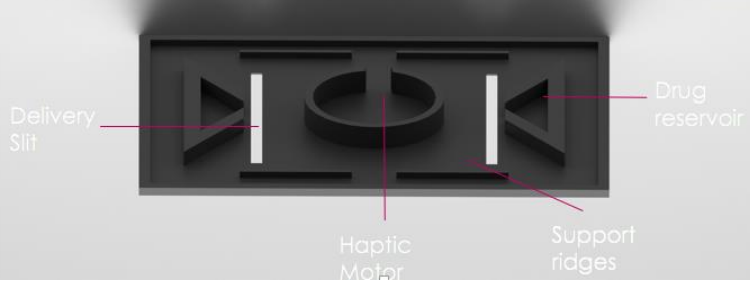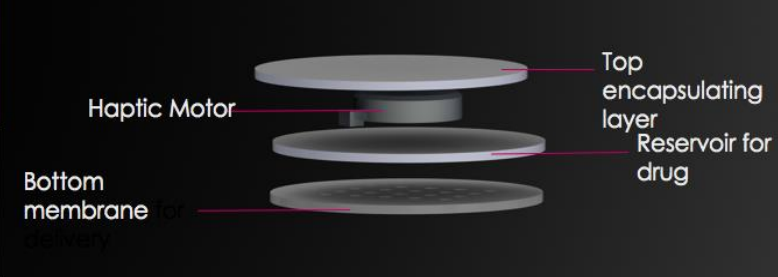Modern-day medicine has advanced enormously in methods for pain management in the last decades, and thankfully so for patients who are in dire need. If you have ever been seriously injured or debilitated by an illness that was accompanied by severe physical discomfort, then you are aware how helpful a fast drug delivery system can be. And as 3D printing has lent the power of innovation to so many corners of the medical field, it may also begin to play a larger role in dressings and pain relief mechanisms.
Munam Arshad recently authored ‘Controlled Drug Delivery System for Wound Healing and other Biomedical Applications,’ outlining how useful such techniques can be in serving (and healing) the patient better, as well as creating more efficiency for medical professionals. With a 3D printed device, the drugs are delivered via a vibrating mechanism that moves the medications through small ‘slits.’
“The device is made up of a biocompatible polymer which is 3D printed and one complete unit which houses the drug reservoir and the haptic motor,” states Arshad in his paper. “Different dosage regimes can be constructed for different drugs; the concentration can be modified by changing the amount of time the device is turned on. The static and dynamic studies perform in the research provide the guidelines for constructing different dosage regimes.”
The dressing of wounds is a process that has been necessary since the beginning of medicine itself, meant to eliminate both infection and pain, and promote healing. The goal for any human is to see them heal as quickly as possible too, and Arshad points out that scientists today seek smarter ways to dress wounds while promoting better elimination of bacteria and offering relief from what can sometimes be enormous physical discomfort. Conventionally, wound dressing has meant the patient was either in the hospital being cared for continually or having to travel back and forth to a doctor’s office.
Researchers like Arshad see the need for more progressive devices and techniques and are looking toward both FDM and SLA 3D printing to advance these goals—and with the accompaniment of smart electronics for monitoring. Materials science comes into play here heavily as well as dressings must be compatible with the human body, and affordably so too.
“The synthetic polymer helps to reduce scab formation in the wound also managing to elevate the movement of the growth cells into the wound. Use of synthetic polymer also manages to obtain a better rate of epithelial cell organization,” states Arshad. “Thus, we can say that a functional wound dressing should be able to wrap around the given site of the wound firmly and at the same time enable the better healing environment to the wound, it should also help to reduce the amount of pain making it easier for the patient to transition back to their normal routine.”
The researchers settled on PMC-744 as the material of choice due to its biocompatibility and flexibility—both requirements for the device. After that, the research team began working on the vibrating mechanism for delivering the drugs, with several different iterations in place before they settled on the final 3D printed model featuring one system with both a haptic motor and drug reservoir with drug release area. The model was created in SOLIDWORKS and then 3D printed in PLA.
The 3D printed device should prove to be helpful in two different areas, at least:
“The first one is the use of the device on the living beings such as rats and ultimately for humans which is the desired goal, however the prototype is still far off from how the final device would be like, but in the future it can be used to replace conventional methods of drug delivery and bandages for better wound healing solutions,” states Arshad. “The second application involves the use of the drug delivery system in the laboratories to study the anti-microbial activities of the drugs for better study of wound healing.”
“The device can be programmed to deliver specified amount of drug at specified intervals in a day or even for greater time intervals. This can be used as an automated drug dispensation system for the clinicians without the requirement of frequent intervention to manually deliver drugs.”
Extensive testing was performed on the device, but there is still plenty of room for improvement, according to the research team. Read more about this drug delivery device here. What do you think of this news? Let us know your thoughts; join the discussion of this and other 3D printing topics at 3DPrintBoard.com.
[Source / Images: ‘Controlled Drug Delivery System for Wound Healing and other Biomedical Applications’]Subscribe to Our Email Newsletter
Stay up-to-date on all the latest news from the 3D printing industry and receive information and offers from third party vendors.
Print Services
Upload your 3D Models and get them printed quickly and efficiently.
You May Also Like
Consolidation in AM: How 2025 Is Shaping the Industry’s New Normal
The first half of 2025 has been marked by a clear shift in the additive manufacturing (AM) industry. Companies are no longer just focused on developing new tech by themselves....
Etsy Design Rule Change Reduces Selection of 3D Printed Goods
Online marketplace Etsy has implemented a rule change requiring all 3D printed goods on the site to be original designs. The update to the site’s Creativity Standards states, ¨Items produced using...
U.S. Congress Calls Out 3D Printing in Proposal for Commercial Reserve Manufacturing Network
Last week, the U.S. House of Representatives’ Appropriations Committee moved the FY 2026 defense bill forward to the House floor. Included in the legislation is a $131 million proposal for...
Transforming From Tourist to Native: Duro CEO Michael Corr Explains Why the Company Rebuilt its PLM Software on AI
In these early innings of the AI boom, many market analysts have expressed concern that AI spend has gotten too far ahead of the technology’s proven ability to deliver significant...



































